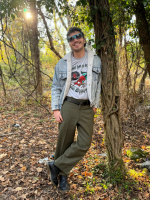A 24-year-old, one-eye horse named Ernie is about to get an injection straight into his jugular vein.
For all intents and purposes, he takes it pretty well, he barely notices the prick and soon his head is drooping.
Dr. Justin Sobota is the veterinarian administering the injection at Sunset Hill Farms in Woodbine, Maryland. Ernie needs some electric shock therapy on his back leg to help torn muscles and ligaments grow faster.
What Sobota gave Ernie is a tranquilizer similar to xylazine, a drug that is fairly new on the streets of Baltimore, but has been used by vets to sedate large animals for decades.
“We do use xylazine quite a bit. And it's very important, I keep it with me all the time,” Sobota said. “Now, I'm going to try to lock it up a little bit more in my controlled drug box, if you will, just because of what's happening nationally.”
Xylazine is known as tranq on the streets and is making its way into the illegal opioid supply throughout the nation. The Drug Enforcement Administration found traces of the drug in opioids in at least 48 states and a new Centers for Disease Control and Prevention study found that tranq was present in 11% of the nation’s opioid overdoses in June.
The drug is much more prominent in Maryland. The CDC found that 80% of opioids tested at eight needle exchange sites in the state had tranq mixed in.
The drug is especially dangerous because it further depresses vital bodily functions, increasing the risk of overdose. A life-saving overdose reversal drug called Naloxone doesn’t work on tranq, making it even more concerning. People who end up taking the drug once it’s mixed in with their opioids can develop flesh wounds all over their body.
The Biden administration designated the drug as an emerging threat in the nation, but in most of the country it still remains a legal substance.
However, vets say cracking down on the drug could have unintended consequences. Two states, Ohio and West Virginia, have already make the drug a controlled substance.
“Traditionally, xylazine is one of those injectable products that I've kept right at the front of the drawer that's within the easiest reach because in some cases, you need that sedation effect very, very quickly,” said Dr. Eric Gordon, a large animal vet in Ohio and president of the Ohio Veterinary Medicine Association.
Now, if an animal is in danger of harming itself or the people around it, Gordon needs to go through a legally required two-lock system to access the drug.
That’s not the only issue, however.
Dr. Jim Zeliff, a veterinarian who has a leadership role at the American Association of Equine Practitioners, says restricting the drug could add cost for vets and animal owners.
Often, a doctor might leave a small quantity of the drug with an animal owner to help change a horseshoe or do a routine procedure that doesn’t require a vet. Now, animal owners will need to call the vet back out in those situations.
There are some drug alternatives for horses, but other tranquilizers can be dangerous for cattle, pigs and other large animals, leaving vets with few other options. The alternatives tend to be about twice as expensive as xylazine, costing about $80. Xylazine’s cost could increase with the restrictions as well.
Gordon says he’s already seen a price increase, but that’s partly because the drug is having supply issues as well.
There are only two companies that manufacture xylazine in North America. One company has already said that controlling the substance could make it too expensive and unwieldy to market, ultimately increasing the cost for vets and animal owners or making it unavailable altogether.
“I have talked to some veterinarians in Ohio that just discontinued dispensing xylazine to their large animal clients because they it's just a headache that they don't necessarily want to have to deal with down the road,” he said.
The DEA says xylazine on the street is rarely coming from vets. Instead, it’s easily bought in bulk powder form from overseas distributors in China for less than $20. Gordon said vets don’t use the powdered form of the drug.
Sen. Catherine Cortez Masto (D-Nev.) introduced a bill in March that would restrict human consumption of the drug, while still making it easy to procure for vets. However, Congress has yet to do anything with the bill.
Meanwhile, on July 11, the Biden administration issued a national response plan for the drug. The plan focuses on testing and data collection to understand where the drug is coming from and keeping people safe from it.











